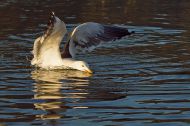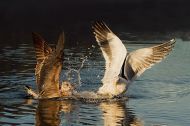Kelp Gull
Gaviota Cocinera
Larus dominicanus
Length: 650mm. Sexes alike. Bill yellow with a red spot on the tip of the mandible; eyelids red; iris pale yellow or silver white; head, neck and underparts mostly pure white; back and scapulars black, greater scapulars show a white spot to tip; rump, uppertail coverts and rectrices pure white; bend of wing white; wing coverts and remiges black, both secondaries and primaries show a broad white terminal band, the outer primary shows a subterminal white spot; underwing coverts and axillaries pure white. Legs greenish yellow.
Juvenile: bill and legs blackish brown; head, neck and underparts are brown with buff whitish striation, imparting a greyish appearance; upperparts are brown margined with whitish buff; rump and uppertail coverts are white with brown barring; rectrices brown narrowly margined with whitish buff, the feathers are striated with whitish at the base; wing coverts dark brown with feathers margined buff; remiges dark brown. Between the first immature plumage and the adult plumage there are several transition phases, the definite plumage being acquired at age four. Females are smaller than males. The Kelp Gull is the largest species of the Laridæ family that occur in the southernmost part of America. Similar species: readily identified, only during the immature stages or subadult stages can it be confounded with the young of the Band-tailed Gull (Larus atlanticus), whereas the adults can be told from the latter chiefly by lacking the band in the tail feathers. Habitat and behaviour: very common and abundant, it is one of the best known birds; it is found in pairs or in flocks that in the feeding, roosting or breeding grounds may gather by the hundreds.
This species frequents a wide variety of environments; it inhabits both the coasts of the continental and insular maritime littoral and inland lakes, ponds, rivers, fields as well as waste dumps around urban areas. Over land it moves with great agility. To become airborne it taxis along briefly, sometimes rising to considerable heights and gliding with thermal drafts. When covering long distances it beats its wings continually. The flight is not particularly as fast as it is powerful. It feeds on all types of animal matter. Its varied carnivore diet includes fish, crustaceans, molluscs, dead animals, placenta found in the colonies of sea mammals, eggs and the young of other species of seabirds and occasionally of their own, carrion and refuse of slaughterhouses and garbage dumps. The nests are in very large colonies, almost invariably associated with other species such as cormorants, penguins, other gulls and terns. The nest is placed in a simple hollow on the ground in sandy or muddy beaches and in rocky areas on the seashore. Inland it breeds in marshes, lake margins, ponds and river mouths. The nest consists of grasses, feathers, moss, sea algae and pebbles, although on occasion it is placed directly on the ground, with no lining at all. Clutch size is up to four olive-coloured eggs with brown and blackish mottling. Both parents are in charge of incubating, feeding and looking after the hatchlings. Chicks are born with a concealing coloured down and they remain in the nest for one or two days, at which time they leave and hide in the vicinity awaiting to be fed by their parents. In the presence of danger the chicks lie flat, relying on their colour to protect them. Range: widely distributed in subantarctic and Antarctic regions of the Indian and Pacific Oceans. In Argentina it is found from the Argentine Antarctica to South Shetland, South Orkney, South Sandwich and South Georgia islands, Isla de los Estados, Islas Malvinas and coasts of Tierra del Fuego as far north as Buenos Aires and further north reaching Brazil through the Atlantic. On the South American Pacific coast it occurs from Cape Horn to Peru and occasionally Ecuador. Inland it occurs in lakes and other water bodies as well as near human settlements, from Tierra del Fuego to Neuquén and Río Negro in Patagonia, and further north to Buenos Aires, Entre Ríos, Santa Fe and Córdoba.
Illustrated Handbook of the Birds of Patagonia
Kindless: Kovacs Family
|













